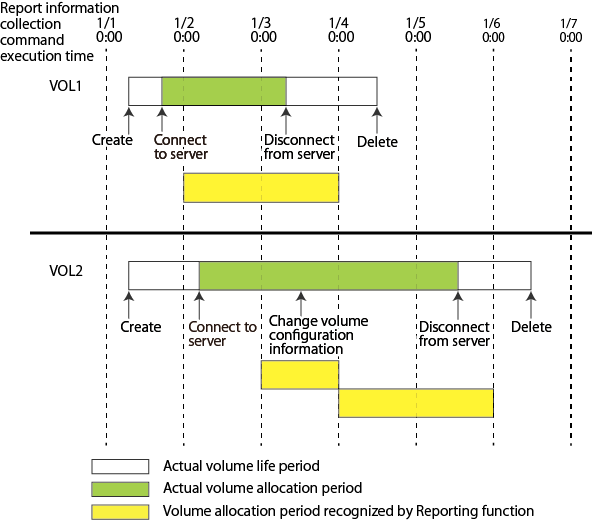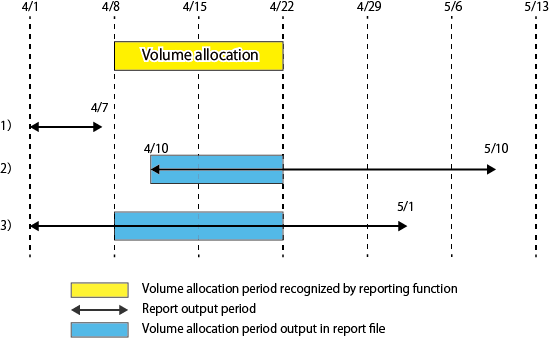For assistance in defining a charging method, the following example cases are provided. Based on the following requirements, do various settings of the Reporting function and create an accounting application:
Range of charged servers
Charge a fee per server and send an invoice.
Charge a fee per group of multiple servers and send an invoice.
Unit of charged time
Charge a fee per hour.
Charge a fee on a daily basis.
How to calculate fees
Set a unit price per volume capacity to calculate fees based on allocation and usage period.
Set extra/reduced fees based on volume additional information.
When and for which period to make an invoice
Charge usage fee for the previous week at 3:00 AM every Monday.
Charge usage fee for the previous month on the 10th of each month.
How to deliver the invoice to the center user
Send usage fee to the user by E-mail.
Print out the invoice to send to the user by post.
What to do if collecting charging information or making an invoice fails
Sound an alarm using the buzzer.
Send a notification E-mail to the center administrator.
Concept of Volume Allocation Period
Since the Reporting function calculates a volume allocation period from periodically collected information, the actual volume allocation period allocated by the center user is different from that recognized by the Reporting function. Basically, an allocation period for one volume is a period from when volume is connected to server to when volume is disconnected from server. However, if the configuration information for a volume connected to server has been changed, the volume is handled as a new volume. In this case, two volumes are output ("Volume configuration information is changed" indicates that any element other than the Header information written in "Table 8.2 Attributes Maintained by Elements" has been changed). The output on a per volume configuration basis makes it possible to charge fees in accordance with the volume configuration.
The start/end date and time of using a volume allocation period recognized by the Reporting function is defined as follows:
Start date and time of use
Date and time when the report information collection command was run after server connection or configuration information for volume connected to server has been changed.
End date and time of use
Date and time when the report information collection command was run after server disconnection or volume configuration information has been changed.
The following is an example of running the report information collection command per day:

The volume allocation period recognized by the Reporting function is as follows:
VOL1
0:00 of 1/2 to 0:00 of 1/4 (2 days in all)
VOL2
0:00 of 1/3 to 0:00 of 1/4, and 0:00 of 1/4 to 0:00 of 1/6 (3 days in all)
Since in this example a collection interval is set to one day, a maximum of 23 hours and 59 minutes of error is caused. The relation between information collection interval and error is as shown in "Table 8.1 Influence Rate by Information Collection Interval and Collected Information Amount".
Information Collection Interval | Accumulated Information Amount | Time Lag Reflected in Report Information |
|---|---|---|
Long | Little | Large |
Short | Large | Small |
Concept of Volume Allocation within Report Output Period
Report information is output in the report file based on the volume allocation period recognized by the Reporting function within a report output period. The point where the report output period specified by the user when creating a report overlaps the volume allocation period recognized by the Reporting function is a volume allocation period output into the report file.

The volume allocation period recognized by the Reporting function is 4/8 to 4/22. In the following report output period, a volume allocation period output in the report file is as follows:
No. | Report Output Period | Volume Allocation Period Output in Report File | Remark |
|---|---|---|---|
1) | 4/1-4/7 | None | Report output period is out of volume allocation period. |
2) | 4/10-5/10 | 4/10-4/22 | - |
3) | 4/1-5/1 | 4/8-4/22 | - |
The report creation command removes the old information exceeding the period preset by the policy from the information stack file.
First, define how long to retain report information. A report information retention period is defined based on the following factors:
Possible restrictions from the purpose of use
Retention period by internal control
Backup interval of information stack file
Interval of creating a report
Interval of collecting information, etc.
Quotation of the information stack file capacity based on the configuration of an assumed storage system
Refer to the Installation and Setup Guide for information on estimating the information stack file capacity.
The defined retention period is enabled by being set in the policy file.
See
Refer to "8.3.2.2 Setup Policy" for information on how to set a retention period.
Note
The report information is deleted based on the retention period set in the policy file when the report creation command is run. For this reason, if the report creation command is not run even though the report information in the information stack file exceeds the retention period, the report information is not deleted.